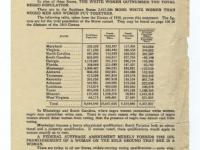The 1910s were an era of violent racial conflict. Major riots occurred in Southern and Midwestern cities, and Northern whites adjusted uneasily to the massive influx of migrating African Americans seeking opportunity in urban centers. Rather than making common cause with oppressed African Americans, the suffragists, particularly those affiliated with NWSA, sought to distance themselves from their black counterparts. Buying into the Social Darwinist ethos of their era, many leaders of the woman suffrage movement were bitter that African American men had been given the franchise before them, and they did not want questions about “The Race Problem” to interfere with passage of the 19th Amendment. Although significantly larger percentages of black than white women believed that they deserved the franchise, and although black leaders like Ida Wells-Barnett and Mary Church Terrell spoke out for voting rights, the major woman suffrage organizations discouraged the participation of African American women.
In addition to being mostly white and native-born, activists in the woman suffrage movement were generally from the top of the socioeconomic ladder. In spite of their lack of leadership in the movement, working-class women, particularly those who were part of the war effort, were utilized as evidence of women’s critical role in American society and as an illustration of why women deserved the right to vote.


